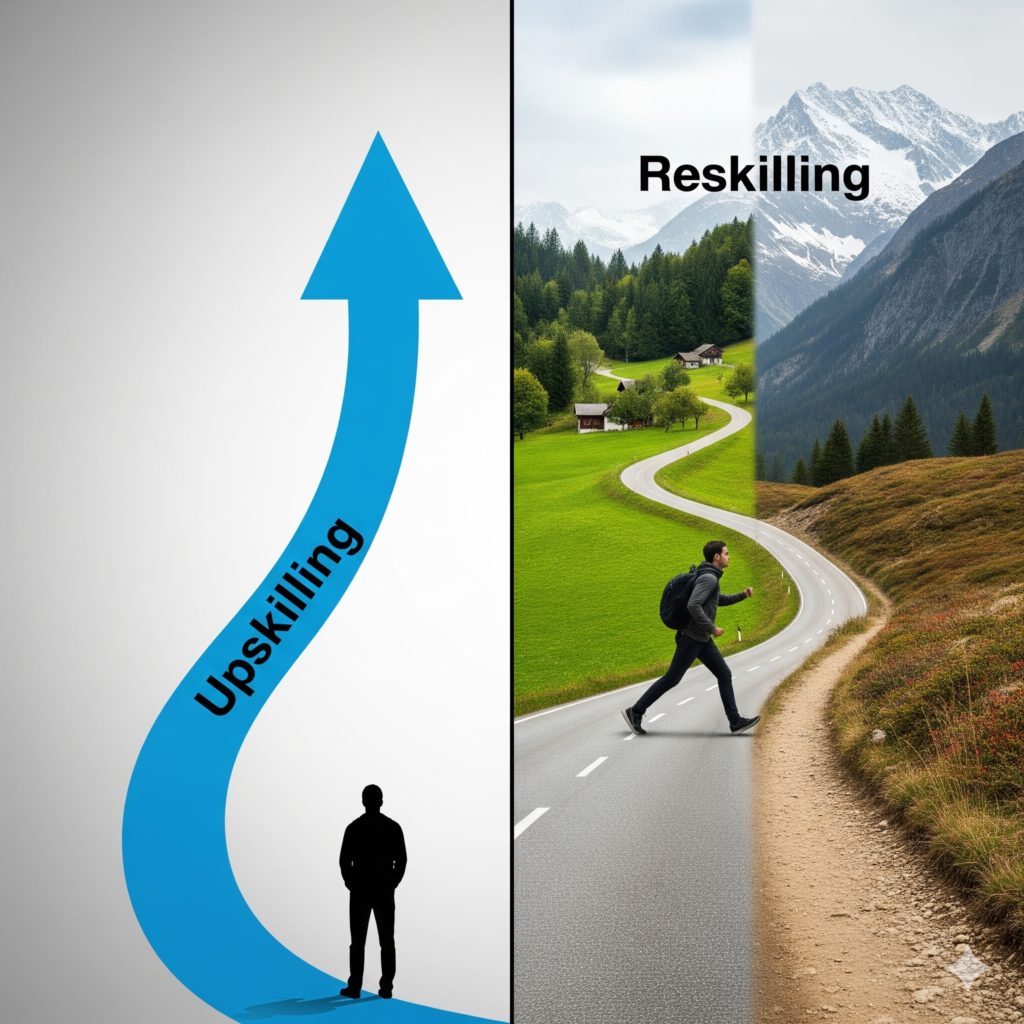Introduction: The Changing Landscape of Work
The world of work is undergoing rapid and unprecedented transformation. Technology, automation, globalization, and shifting business models are fundamentally changing how we work, what skills are required, and which jobs will exist in the future. In this evolving landscape, the only true constant is change itself. For professionals across industries, adapting and updating skills isn’t just an option—it’s a necessity. Reskilling, which means learning new skills or adapting existing ones, is fast becoming the key to career security. In this blog post, we’ll explore how the future of work is shaping the demand for reskilling, why it’s vital for everyone from entry-level employees to senior executives, and what actionable strategies you can use to futureproof your own career.
Why Reskilling Matters More Than Ever

As businesses evolve to keep pace with technological innovations and economic disruptions, the half-life of skills is shrinking fast. Skills that were highly desirable five years ago may have already become obsolete. Artificial intelligence, robotics, and digital platforms are automating repetitive tasks, increasing demand for critical thinking, problem-solving, and emotional intelligence. Entire roles are disappearing, while new ones are emerging. Reskilling ensures that individuals are not left behind. It empowers workers to pivot into new domains, take on different responsibilities, and maintain relevance in the job market. Without ongoing reskilling, professionals risk redundancy and diminished earning potential. In essence, reskilling is no longer merely a personal development activity—it’s a core survival strategy in the modern workforce.
The Impact of Automation and AI on Jobs

One of the major drivers behind the current emphasis on reskilling is automation and artificial intelligence. According to global studies, millions of jobs worldwide are at risk of being automated in the coming decade. While automation eliminates certain tasks, it also creates new opportunities in fields like data analysis, machine learning, and cyber security. The key lies in understanding that technology augments rather than eradicates the workforce. Those able to adapt and harness new technologies will thrive, while those resistant to change may find themselves displaced. Industries most affected include manufacturing, finance, retail, logistics, and even creative fields. As AI becomes more capable, the value shifts away from rote skills toward creativity, adaptability, and digital competency—areas where reskilling has the biggest impact.
Reskilling vs. Upskilling: What’s the Difference?

These terms are often used interchangeably, but there are crucial differences. Upskilling refers to improving current skillsets to perform better within your existing career path. For example, a marketer might learn advanced SEO strategies or analytics tools. Reskilling, meanwhile, is about learning entirely new skills to move to a different role or industry. This could involve transitioning from a sales role to digital marketing, or from administration to data analysis. In uncertain times, both processes are important, but reskilling is more likely to involve a bigger shift and provide greater flexibility. By investing in reskilling, professionals expand their career options, making themselves more resilient in the face of change or disruption.
Industries Most in Need of Reskilling

While reskilling is relevant to all professions, certain sectors feel its urgency more acutely. Manufacturing, retail, and finance are seeing rapid technological adoption, transforming the skills their workforce must have. Health care is integrating telemedicine and AI diagnostics, requiring medical professionals to learn new digital tools. Education is shifting to hybrid and online models, pressing teachers to adopt new methodologies. Even tech itself is evolving so fast that tech workers must constantly reskill. More broadly, gig economy workers, freelancers, and those in administrative support roles are experiencing shifts in client expectations and available contracts. In each case, the professionals who proactively reskill stand out as adaptable and valuable.
How Companies Benefit from Employee Reskilling

Businesses recognize that investing in employee reskilling is not just socially responsible—it’s a strategic necessity for growth and sustainability. Organizations with a culture of learning are more likely to innovate, attract top talent, and remain competitive. Reskilling programs reduce turnover, improve employee engagement, and enable companies to deploy their people in new areas as opportunities arise. This flexibility supports digital transformation, helps adapt to regulatory changes, and futureproofs the organization against economic upheavals. As companies prioritize reskilling, they also build a more inclusive environment, where diverse employees are given the tools to thrive regardless of their starting point.
Practical Strategies for Reskilling Yourself

Taking charge of your own reskilling journey is both empowering and practical. Start by assessing the market—identify which roles are growing and what skills they require. Take advantage of free and paid online courses, certificate programs, and micro-credentials through platforms like Coursera, Udemy, LinkedIn Learning, or even employer-sponsored training. Network with professionals in target industries and seek mentorship when possible. Focus on transferable skills such as digital literacy, communication, project management, and data analysis. Document your progress on a personal website or portfolio to showcase your new abilities. Crucially, set a reskilling schedule and stick to it—consistent effort over time makes a dramatic difference .Reskilling for career security
Role of Online Learning and Micro-Credentials in Reskilling

The explosion of online learning has made reskilling more accessible than ever before. Micro-credentials and digital badges offer condensed, outcome-focused training that proves mastery of specific competencies. These programs are often stackable, allowing learners to move from foundational skills to advanced specialization at their own pace. Employers are increasingly recognizing these credentials, making them valuable for job seekers and career changers. The flexibility of online platforms means even busy professionals can fit reskilling into their schedules. By embracing lifelong learning, individuals unlock new career paths and demonstrate initiative to prospective employers.
Reskilling for the Gig Economy and Freelancer Success

As traditional employment models shift toward freelance and gig-based work, reskilling is critical for maintaining relevance and income stability. Freelancers benefit from a broader skill set that allows them to attract more varied clients, command higher fees, and transition fluidly between different types of work. Gig economy platforms increasingly favor workers who demonstrate digital skills, adaptability, and self-management. Investing in self-paced training courses, portfolio development, and networking communities supports ongoing growth. For freelancers, reskilling isn’t just about learning technical abilities; it’s also about business acumen, marketing, and client relations in a dynamic marketplace.
The Human Side of Reskilling: Mindset and Motivation
The journey of reskilling can be challenging, requiring a growth mindset, resilience, and adaptability. It’s natural to feel intimidated by new technologies or unfamiliar domains, but maintaining motivation is key. Break learning into manageable steps and celebrate small wins. Connect with peer groups or support communities to share experiences and keep accountable. Remember that the ability to change and learn is a core human trait. Employers look for individuals willing to stretch beyond their comfort zone. Cultivating curiosity and a positive attitude toward change makes the process rewarding—and sets the foundation for lifelong career growth.
Common Barriers to Reskilling (And How to Overcome Them)
Many individuals face obstacles when considering reskilling, such as time constraints, financial concerns, or fear of failure. However, these barriers can be overcome with planning and determination. Prioritize learning just as you would any critical work task. Seek out free resources or scholarships if cost is an issue. Start with small, achievable goals rather than trying to master everything at once. Find accountability partners or join learning cohorts. Remember, the goal of reskilling is not instantaneous mastery but consistent, ongoing improvement. Every new skill learned opens doors that were previously closed.
Real World Examples: Success Stories of Reskilling
Across industries, countless professionals have transformed their careers through reskilling. Take the story of a graphic designer who learned UX/UI design and transitioned to a role in product development. Or the factory worker who retrained in programming and now manages automation systems. Companies have run successful reskilling pilots—like AT&T’s Future Ready initiative, which equipped employees with digital skills for new roles. These examples prove that reskilling is accessible to anyone willing to invest the effort, and demonstrate that career security is not static but dynamic and achievable through learning.
The Role of Government and Policy in Reskilling for career security
Governments and policymakers have a crucial part to play in driving reskilling initiatives. Many countries are investing in public training programs, tax incentives for education, and partnerships with industry to create new curriculum standards. Policy shifts toward lifelong learning and workforce development help citizens remain competitive in the digital age. By encouraging collaboration between employers, educators, and policymakers, society can support larger-scale reskilling efforts that benefit everyone, closing the skills gap and reducing unemployment.
Frequently Asked Questions about Reskilling and Career Security
1. What is the difference between reskilling and upskilling?
Reskilling means learning entirely new skills to change your job role or industry. Upskilling is improving your current skillset for better performance in your existing position.
2. How do I identify which skills to learn for future job security?
Review job market trends, talk to mentors, and research growing industries to find in-demand skills. Focus on digital, analytical, and communication skills as core areas for future-proofing.
3. Can reskilling lead to a career change?
Absolutely. Many professionals successfully switch careers through reskilling, moving into more sustainable and better-compensated roles.
4. What resources are available for affordable reskilling?
Free online courses (Coursera, Udemy, Khan Academy), industry certifications, government grants, and employer-sponsored training are popular options.
5. How can I stay motivated during the reskilling process?
Set realistic goals, build a learning routine, join support communities, and reward yourself as you reach milestones.
Conclusion: Reskilling for career security
The future of work is filled with opportunity for those willing to embrace change. Reskilling offers the best insurance against career insecurity—unlocking new roles, industries, and income streams. By actively engaging in ongoing learning, developing transferable skills, and staying nimble in the face of disruption, you set yourself up for long-term security and satisfaction. The time to start is now. Take stock of your skills, set your learning goals, and join the movement toward empowered, adaptable careers. The future belongs to the Reskilling for career security
